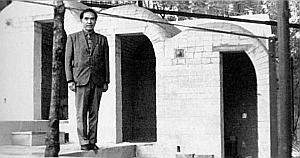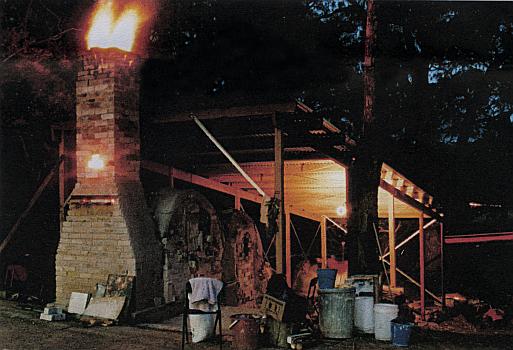![]()
Sturt
Craft Centre and Wood Firing at Sturt Pottery
by
Megan Patey
(Head of Sturt, September
2002)
|
|
Sturt
Craft Centre and Wood Firing at Sturt Pottery |
Sturt Craft Centre was established in 1941, as a site for the production and training of high quality craft. Commencing with textiles, and followed by wood, ceramics, metalwork and jewellery, the studios developed over a thirty year period to become on of the most significant places for craft training and practice in Australia. Sturt is ideally situated 100 KMS south of Sydney, close to major public transport routes, and a convenient stop between Sydney and Canberra. As well as six large studio/workshops, the facilities at Sturt include gardens, a Café, Shop, high profile Gallery and motel unit. Sturt attracts many visitors each year and is one of the recognised tourist attractions in the Southern Highlands of NSW.
Sturt Pottery was the third workshop to be established at Sturt, in 1953 by Ivan McMeekin. In its fifty year history, Sturt Pottery has had eight managers and over fifty trainees, many of whom have gone on to become well known potters or makers. The Pottery has continued at all times to follow a program of production as well as training. This follows the philosophy of all training at Sturt, which is practically based and is designed to give all students invaluable workshop experience.
Wood Firing at Sturt Pottery In the fifty year life of Sturt Pottery, many kilns have come and gone. The first wood firing at Sturt Pottery was held on 28th September 1954. Not only does this mark the inaugural firing at Sturt, but it also marks the first use of the bourry box in Australia.
Ivan McMeekin encountered the bourry box in 1950 while working with Michael Cardew at Wentford Bridge Pottery in Devon. Cardew’s kiln was temperamental. So in typical fashion, McMeekin set about researching the bourry box, to see how it functioned, and to see how he could improve its efficiency. McMeekin was to use the bourry box many times for a variety of kilns, which he built during his long teaching and potting career throughout Australia. It was indeed partly through his influence that the bourry box became such a popular type of firebox with many Australian potters and has gone on to be the favoured firebox in use amongst most Australian wood-firers today.
Ivan McMeekin was a significant figure for Australian ceramics. His research into Australian clay and glaze materials, which resulted in “Notes for Australian Potters”, is still the most exhaustive study of its kind available today. His six years at Sturt Pottery was an important catalyst for the development of Australian ceramics. He introduced the ideas of Leach and particularly Cardew to Australia, with the emphasis on the use of local materials for small-scale studio production.
In 1959, Les Blakebrough followed Ivan McMeekin as manager of Sturt Pottery. The sixties was a fertile time for the growing ceramics movement both in Australia and overseas. Numerous international potters visited Sturt during this time – and as a result of meeting John Chapell, Blakebrough visited Japan for a year during 1962. The influence of Japan has been a constant source of inspiration for Australian potters, and particularly for those who work at Sturt. Several of the pottery’s managers and students have worked and studied in Japan before coming to Sturt, including Paul Davis, Libby Pickard, Aaron Scythe as well as Les Blakebrough.
In 1964, Les Blakebrough built the three-chambered climbing kiln at Sturt. The main fuel for this kiln was oil although wood was used secondarily for side stoking.

Takeichi
Kawai and the three-chambered kiln
With Les Blakebrough’s departure in 1972, wood firing lay dormant as oil and gas kilns were built at Sturt, under the directions of John Edye (1974-78), Paul Wynn (1978-80), Ian Mackay(1982-86) and Campbell Hegan(1988-98).
However during this time, wood firing was flourishing in the rest of Australia. Partly due to a regular series of wood-firing events and conferences organised by Janet Mansfield, and partly due also to Australia’s physical attributes, which produces suitable hardwoods plus the availability of land for studios, wood firing has become popular with many of the Australian potters. This influence eventually touched Sturt, and in 1994, Aaron Scythe built a 15-metre long anagama kiln.
This kiln has become an important addition to the pottery’s facilities. For the last eight years, it has attracted potters, students and international residents, who come to Sturt to make and fire the anagama regularly. Wood comes from a nearby pine mill as well as off-cuts from local tree surgeons. A mixture of pine and hardwood is used, and the kiln generally fires for three to four days.
Libby Pickard built a second wood kiln at Sturt in 2001. This was a fast firing single chambered kiln. Libby was Pottery Manager for three years and has since left to live and work in Japan. In 2002 a second chamber was added by Paul Davis, now the Sturt Potter, and Fergus Stewart. The second chamber is used for salting.

Two
chamber kiln at Sturt Pottery
Sturt Residency Program In 1999, the Artist-in-Residence Program was established at Sturt Craft Centre. This program invites high profile makers to Sturt to work in their chosen discipline for three months in exchange for accommodation, a stipend and an exhibition at Sturt Gallery. This program is ideal for senior craftspeople that see a need to invigorate their practice, expand their contacts, and gain new skills. In 2001, under the Residency program, Svend Bayer spent three months at Sturt. He made enough pots for two anagama firings, most of which were exhibited in the successful exhibition at Sturt Gallery - One Hundred Pots at Sturt Gallery. Svend was also a tutor at the Sturt Summer School for one week, and he captivated many visitors and students with several slide shows.
The Residency program is open to all disciplines and practices.
Studio Tenancy positions Studio positions are offered in the areas of wood and ceramics. In exchange for rent of $80 per week, an allocated space plus use of all equipment and facilities is provided. Tenants pay for their own materials, and fuel consumption, but have full access to all equipment and resources at Sturt. This includes exposure to a dynamic retail environment, exhibitions, slide presentations, plus interaction with other students.
For any enquiries regarding Sturt Pottery positions, the residency program, or for any of Sturt other activities, visit the website at www.sturt.nsw.edu.au
Sidestoke
home
| Paul
Davis home